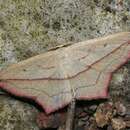en
names in breadcrumbs


Timandra is a genus of moths in the family Geometridae first described by Philogène Auguste Joseph Duponchel in 1829.
Timandra was raised by Duponchel and is taken from Greek mythology and is named after the daughter of Tyndareus and Leda.[1]
Palpi not reaching beyond the frons. Antennae of male bipectinate (comb like on both sides). Apex simple. Hind tibia of male with two spur pairs. Forewings with acute and produced apex. Vein 3 from near angle of cell and vein 5 from somewhat above middle of discocellulars. Veins 7, 8 and 9 stalked. Vein 10 anastomosing (fusing) with veins 8 and 9 to form the areole. Hindwings with produced outer margin to a point at vein 4, veins 6 and 7 from angle of cell.[2]
Timandra is a genus of moths in the family Geometridae first described by Philogène Auguste Joseph Duponchel in 1829.